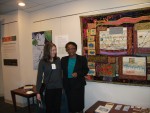Reflections is an outstanding collection of science translated into artistic form and is on display at the National Science Foundation (NSF). The exhibit is composed of work created from artist and scientist collaborations at three LTER sites: Harvard Forest, North Temperate Lakes, and Bonanza Creek.
The Long-Term Ecological Reflections network developed as a result of outreach activities at several of the LTER sites to produce creative responses that reflect each site’s diversity of scientific-research goals and historical and cultural contexts. The goals of Reflections are to connect the arts and humanities with science, to bring these combined perspectives to bear on complex ecological questions, and to connect the public to science on aesthetic, emotional, and philosophical levels.
The exhibit begins with a beautifully embroidered quilt -- colorfully covered with graphs, maps, animals and definitions inherent to lake ecosystems. Bonnie Peterson spent eight months working on the quilt following time in the field with the researchers at the North Temperate Lakes LTER site. On the wall opposite the quilt, a large screen monitor continuously plays a kiosk video of Freshwater Futures featuring water-related research themes being explored at several LTER sites across the U.S. The footage in this montage was collected from the Harvard Forest, North Temperate Lakes, Andrews Forest and Coweeta LTER sites.
As you round the corner, beautiful pastels and watercolors depict past, present and future scenarios of the ecosystems of the Northwoods of Wisconsin. The color of water is explained in the watercolor “Seven Lakes Color Impressions.” Then a meticulously crafted wooden sculpture of a loon diving for a small school of yellow perch amidst a sunken log will capture your attention. Poetry weaves through the visual images as you continue down the hall.
Reflections of the Bonanza Creek LTER begin with a painting of orange walruses amidst a beautiful blue background of Thin Ice. The walruses appear to be playing a game with endangered species, corporations, oil companies, trees … “Who will win?” is the question posed by the artist, Fred Freer. In the bright silk quilt appropriately titled Red-Winged Blackbird, Karen Franzen explores the future scenario of interior Alaska as increased warming cause habitat changes that will expand the range of some species. On the opposite wall are two small quilts of Deneki Lakes: Now and Deneki Lakes: Then, a landscape image of the same scene 50 years apart. A moose and her calf roam the landscape crossing the lake. The decrease in the water level of the lake and habitat changes is well articulated in this eye-catching quilt duo. A sculpture made of wooden shoes, leather, wolf bones, lynx claws, glass beads, and buttons decorates the wall representing a Metaphor for the Future: Hoping for Well-Adapted Children.
Pastels, photographs and paintings from Harvard Forest LTER finalize the exhibit. A graphite and pastel of Chestnut Skeletons and Hemlocks reminds us of the vulnerability of even the most abundant and robust species. On the opposite wall hangs a photograph of a former stand of Eastern Hemlocks. The photograph shows the results of an on-going field experiment to determine the future of New England forest ecosystems if the woolly adelgid continues north, killing millions more of the Eastern Hemlock. Paintings of the Eastern Newt, commonly found in New England forests, depict the animal in the red eft stage. Data collected by the artist, David Bryant, included soil moisture and ambient temperature to investigate correlations between eft color and micro-climate.
The show opened at NSF on February 29 with a reception and tour of the artwork. LTER scientists from most of the 26 different sites attended the opening along with many NSF staff, including Deputy Director Cora Marrett. The exhibit will be on display through June 30.


 Enlarge this image
Enlarge this image
